All flaws aside, Import Tuner Challenge provides a worthwhile and unique racing experience for 360 owners.
Import Tuner Challenge is a game that strides to be different from your average game, which is a breath of fresh air for someone like me. As a gamer that plays dozens of games in a given year, there are times where you just feel like you’re playing the same formulaic titles over and over again. Import Tuner, which is more than just a “spiritual successor” in the Tokyo Xtreme Racing franchise on PS2, gives players the tools to drive the way they want and challenges them to take out the hundreds of rival racers on the highways of Tokyo, Japan. Though it certainly won’t win any best graphics awards by any stretch of the imagination, this game does everything well enough to offer players an interesting and unique racing experience that can’t be found anywhere else.
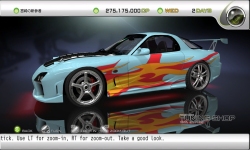
ITC doesn’t really follow a storyline or anything, but if it did, it would show the player as they started from nothing to immerge as the heir apparent to King Speed, the mysterious champion who disappeared from the racing scene a couple years ago altogether. As a newcomer to the illegal street racing scene in Tokyo you will have to learn what it takes to become the fastest racer around by beating those around you. Hundreds of racers, organized into different teams or gangs with their own back stories and racing styles, are vying for the chance to prove what they have, and that means showing it on the streets.
Don’t let that Ubisoft graphic on the box fool you when you boot this one up. Anyone familiar with Genki’s previous Tokyo Xtreme Racing titles on PS2 or Dreamcast will instantly be at home here. A majority of races are structured far differently than the conventional “First to this point wins,” though there are also Time Attack races that use that format here as well. Instead, players challenge one another to what is called a SP Challenge. SP, which stands for Spirit Points, is measured by little life-bars at the top of the HUD (Heads-Up Display). When a racer finds himself behind in a race his bar begins to deplete. The further the distance behind, the quicker the bar goes down. Racers are also penalized for hitting walls, each other, or civilian traffic with SP loss as well. When one bar is empty, the opposing racer drives away victorious.
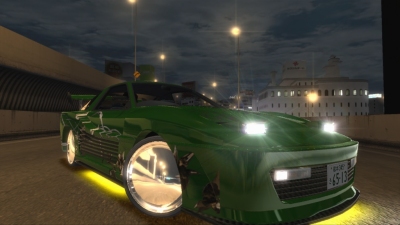
The appeal behind this structure of racing is in its intensity. After challenging a computer driver, your focus must be divided between three things; where you are, where your rival is, and what’s in front of you. Tokyo’s highway system is arranged like most metropolitan expressways, with multiple wide lanes and gentle curves that allow any vehicle a safe street to cruise 60 MPH. A gentle curve at 60 MPH will sometimes be a violent one at 120 or 150 MPH, so knowing what speed you carry into a curve is important in the close races where losing SP in a crash could net you a loss. Once you beat one rival on the streets, the next challenge is often only a mile or so ahead of you in another street racer waiting to have at it. The action is steady without loading screens between challenges, and getting into a groove of 12 or 15 straight races is a regular occurance. This style certainly has its flaws, however. Through the +400 racers that you will face, there are only two different types of races; SP Battle and Time Attack. Anyone who doesn’t instantly fall in love with the concept will never find a reason to come back.
For many, however, this game will win over hearts with the deep customization options available on the tuner cars. Every option imaginable can be adjusted, from the gear ratios on the transmission to the height of the rear spoiler or the angle of your tires. You can even turn a 4WD car into what drives exactly like a rear-wheel drive with the right equipment. Everything you tinker with effects the ride accordingly as it should, so gearheads that want to tear around corners with their rear-wheels spinning can easily do so. As for myself, I prefer to keep my wheels from losing unnecessary tread, so I tune my ride to hold steady as best as possible in corners. The greatest thing is that the developers didn’t chose to force players into drifting, but instead provided them with the physics and the tuning options to do so if they wished.
There is a strong but limited selection of cars to choose here. Japenese car manufacturers Mazda, Toyota, Mitsubishi, and Nissan all have their most popular rides in the game, while Honda’s are completely absent. While I can’t think of a time where Hondas where offered in a Tokyo Xtreme title, I can recall when American and European cars were. Dodge Vipers and Porsche 911s were personal favorites of mine before, but now I am forced to dominate the streets in my Mazda RX-7 (Which isn’t necessarily a bad thing). Custom cars, which become available to purchase after you defeat the rivals that drive them, is a neat little way to drive otherwise unavailable rides, but you can’t mod them past what they are already. This is obviously a pain in the rear end and will keep anyone from actually purchasing one for their garage And one quick note to Genki: next time, give us an option to change the colors of our vinyl graphics for pete’s sake.
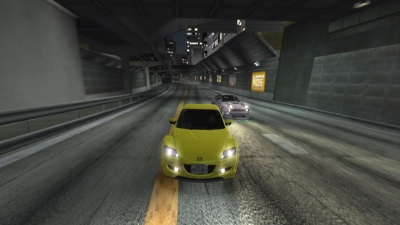
Critics of the prior titles in the series will find that the visuals haven’t improved much in relation to what is available elsewhere. The streets of Tokyo are frequented by the same dozen or so civilian vehicles while the detail of the surrounding city leaves something to be desired. Cars in the distance also suffer from jaggies, which was a huge issue from before and is pretty uncharacteristic for the Xbox 360 hardware. To its defense, however, in HD the game looks decent. Detailing on the asphalt is grainy and realistic, while lighting and reflections make rival cars look realistic. Cars also “animate” accurately as well, carrying momentum on the highway as one would expect in real life. And one can’t forget just how sweet it feels to see your baby on the road, completely decked out with manufacturer stickers and wicked vinyl graphics.
Many complained about the heavy controls of games before this and I never understood why, but the series has never driven better than here in Import Tuner Challenge. Subtly and precision are premium on the streets of Tokyo if you want to run a clean race, which seems appropriate given the game’s faithful recreation of actual highway roads. While not very proficient at drifting, I was able to successfully tune my RX-7 for taking corners sideways instead of braking heavily before the turn. My greatest times were when I tuned for precision turning instead of drifting, especially when I respected the game’s realistic sense of momentum.
One aspect that is completely underwhelming is the poor Xbox Live showing that we find here. Players can either challenge others to a one-on-one SP Battle or take on the Live Leaderboards to try and post the fastest times. Allowing gamers to race three or four at a time on the roads, which will happen in the single player Quest Mode from time to time, would make this a much more compelling and interesting experience. Instead, the online service only serves to post replays of your car in action to show off how well you have pimped your ride.
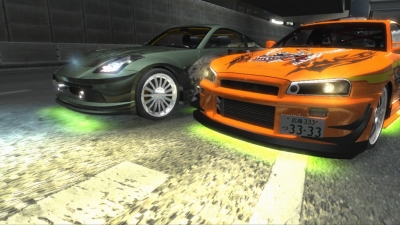
Import Tuner Challenge is certainly without its flaws, but this game certainly deserves to be in the conversation next to Project Gotham Racing and Need for Speed in terms of quality racing titles. Graphics and sound aside, this is one of the stronger racing titles available on the Xbox 360, offering a unique racing experience that can’t be found in Need for Speed, Test Drive Unlimited, or any other titles on the market, and is easy to recommend to any speed freak who thinks as much about tuning as they do racing.
Features:
|
Preview
Hit the highway in Japan without having to pay $12 for a coke. by Patrick Evans
Illegal street racing and tuner-car culture have been around for a very long time, but it wasn’t a pop-culture staple until 2001’s The Fast and the Furious. After that movie made the underground racing scene popular, racing series like Need for Speed took its gameplay into the night, trying to bank on the sudden popularity of street racing. One of the games that were ahead of the curve way back when was Japanese developer Genki’s Tokyo Xtreme Racer on Dreamcast. This title was even in a short clip of The Fast and The Furious as Vin Diesel and cast were lining up for the first big drag race of the movie.
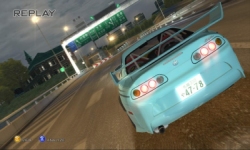
Having been at this a long time, it’s no surprise that Genki is looking to carry its tuner racer to the next generation. This time, with the help of global publishing juggernaut Ubisoft, Tokyo Xtreme is driving under the name of Import Tuner Challenge, promising to bring its unique gameplay structure and racer rosters to the mainstream on the Xbox 360.
Import Tuner Challenge will take place on the real highways of Japan. Part of the series’ appeal was its attempts at authenticity on the road. That sense of realism will be carried onto the 360, and players of the previous Xtremes will recognize many of their favorites that have been dressed up in 720p. Famous highways in Tokyo’s Shibuya and Shinjuku districts will also be included. In previous titles, players were stuck driving exclusively at night. Now, they will be able to challenge rival racers at night, during the day, or in the evening, with each time-zone sporting different traffic patterns and scenery from the others.
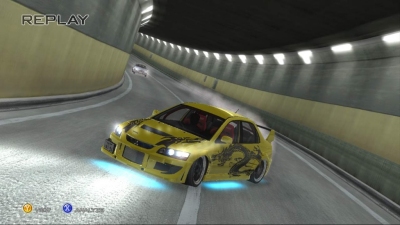
Tokyo Xtreme offered players some of the earliest opportunities to trick out their tuner-cars with spoilers, body kits, and engine components. Import Tuner will carry on that tradition with over 5 million different combinations of licensed tuner parts available for any car. Players will also be able to tweak their cars before hitting the highway to best suit any specific type of competition.
One of the greatest draws of Xtreme was the unique racing format that it featured. Players drive around the streets of Tokyo until they find a fellow street-racer to challenge. After a quick flash of the headlights to state your intentions, you and your opponent enter what is called an SP Battle. Each person has a “life bar” for the race, and the race ends when one racer’s life bar has been depleted. Trailing your opponent or crashing into obstacles deplete the life bar, so the object of each race is essentially trying to get ahead of your rival and run as clean a race as possible. The further a car falls behind, the quicker their life bar depletes. It’s a very simple manner in which to hold a race, but it is responsible for some of the most exciting moments in my videogame racing experience. Knowing that your opponent that seems unreachable can make a mistake at any second and give up the lead, or visa versa, is as gripping as racing on consoles gets.
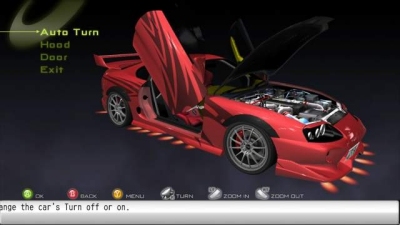
This system works as well as it does because it is built around the rival street-racing gangs that you will have to challenge. As you go through each gang and defeat its members, their leader will challenge you to a race, which is usually much tougher, but much more rewarding. Taking on the gangs in this manner leads to bigger and badder rivals with much nicer cars and modifications. This system of challenging rivals to SP races will remain intact, but you will now be able to challenge racers in the parking lots around the city as well as finding them on the road.
Tokyo Xtreme Racer was a title that polarized many gamers into two categories; those who enjoyed it and those who didn’t. Critics would be quick to point out the repetitive “Race, earn money, upgrade car, repeat” structure that the title was built and label it as redundant. Other knocks included the incredibly slugging control scheme, lack of variety in the “civilian” traffic, and lack of variety in the time of day for every race. Xtreme has made tiny strides in expanding its gameplay as it has progressed on the PS2, but the control scheme has been a constant drag against its overall quality. Online gameplay, which Genki is bringing with Import Tuner Challenge, was never available before either, leaving players to pimp their rides without an audience. Hopefully, with the support of publisher Ubisoft and an excellent graphical potential on the Xbox 360, Import Tuner Challenge can silence the doubters when it releases to the U.S. and Europe this Fall.
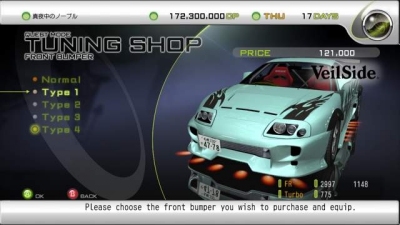
Features:
